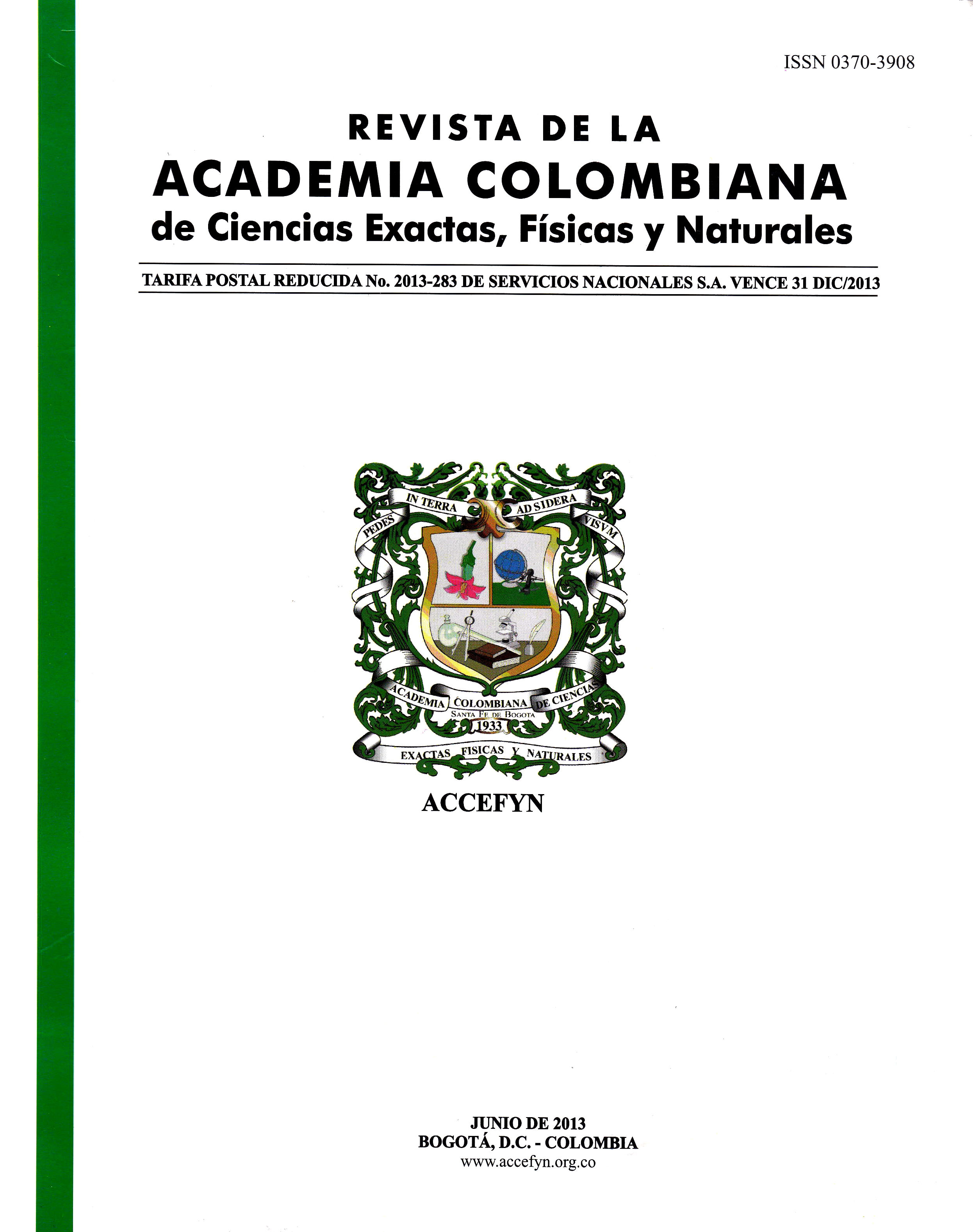Abstract
This work has been elaborated for the presentation as Corresponding Member of the Colombian Academy of Exact, Physics and Natural Sciences. It specifically has an approach on the importance of the understanding of the natural phenomena like the lightning in the millenarian cultures and in the pre-Columbian ones, which had another language different from the scientist, but equally valid to know and to apply these knowledge. And a second focuses on the contributions that the research group PAAS of the National University of Colombia has done to the understanding of the lightning phenomenon.
References
Whipple, F.J.W. “On the association of the diurnal variation of electric potential in the weather with the distribution of thunderstorms over the globe”, Quart. J. Roy. Met. Soc., vol. 55, pp 1-17, 1929.
Brooks, C.E.P. “The distribution of thunderstorms over the globe”, Geophys. Mem. London, vol 24, pp 147-164, 1925.
Gary, C. “La foudre”, Ed. Masson, Paris, pp 208, 1994.
Electrical Transmission and distribution reference book”, Westinghouse Electric Corporation, Pennsylvania, USA, pp. 824, 1964.
Alexander W.H. “The Distribution of Thunderstorm in the United States.” Monthly Weather Review, American Meteorological Society, Vol. 52, No. 7, pp. 337-343, July 1924.
Rakov, V., Uman, M. “Lightning: physics and effects” Cambridge University Press. ISBN 0 521 58327 6. Cambridge, UK 2003.
MacGorman, D., Rust, W. “The Electrical Nature of Storms” Oxford University Press. New York, New York. 1998.
Cooray, V. “The lightning flash” Institution of Electrical Engineers. ISBN: 0-85296-780-2. London, UK. 2003.
Schonlad, B. “Progressive lightning” IV Proc. Roy. Soc. Lond., A., 164. 1938.
Kasemir, H.W. “Qualitative Ubersicht über Potential -, Field -, und Ladungsverhaltnisse bei einer Blitzentlandung in der Gewitterwolke” In das Gewitter, H. Israel, Akad. Verlags. Ges. Geest and Portig K. –G., Leipzig. 1950.
Kasemir, H.W. “A contribution to the electrostatic theory of a lightning discharge” J. Geophys. Res. 65, 643 1873-1878. 1960.
Loeb, L. “The mechanisms of Stepped Leader and Dart Leader in Cloud to Ground Lightning Strokes” JGR 71. pp. 4711-4721. 1966.
Vargas, F.M. “Nuevo modelo integral del canal de la descarga eléctrica atmosférica y su enlace con estructuras en tierra” Tesis doctoral, Universidad Nacional de Colombia, Bogotá, 2006.
Lalande, P., Bondiou-Clergerie, A., Bacchiega, G., Gallimberti, I. “Observations and modeling of lightning leaders” C.R. Physique 3 (2002) pp. 1375-1392. 2002.
F. de la Rosa, K. Cummins, L. Dellera, G. Diendorfer, A. Galván, J. Husse, V. Larsen, C.A. Nucci, F. Rachidi, V. Rakov, H. Torres and M.A. Uman. “Characterization of lightning for applications in Electric Power Systems” Journal Electra - Technical Brochure No. 172, CIGRE WG. 33.01.02, December 2000.
Torres H. “Ground Flash Density: definition of the appropriate grid size and a proposal of relationship Ng vs. Td for Tropical zones” Activity Report of TF.C4.01.02-B. Working Group C4.01 “Lightning”. CIGRE Dallas, Tx., USA, September 2003.
Christian H. J., et al. “Global frequency and distribution of lightning as observed from space by the Optical Transient Detector” JGR, vol. 108, no. D1, 4005, 2003.
Younes, C. “Metodologías para la correlación de Parámetros del rayo con características Geográficas y meteorológicas. Caso colombiano” Tesis de doctorado. Universidad Nacional de Colombia. Bogotá, 2006.
Younes, C. “Lightning parameters evaluation in the Colombian highest atmospheric activity zone” Proc. of ICLP 2004, 2004.
Nucci, Carlo Alberto et al. “On Lightning Return Stroke Models for LEMP Calculations”. Proceedings 19th ICLP. Graz: April 1988.
Rakov, V.A. 1992. Data acquired with the LLP lightning locating systems. Meteor. Gidrol. No. 7: 105-114.
Golde, R.H. “Lightning Vol. 1: Physics of Lightning” Academic Press. New York, New York. 1977.
Lee, S. C. et al. “Determination of Lightning Current Using Frame Aerials”. IEEE Transactions on Power Delivery, Vol. PAS-98, No. 5, Sept./ Oct. 1979. p. 1669-1675.
Key, T. S. and Martzloff, F. D. “A consensus on powering and grounding sensitive electronic equipment,” IEEE/IAS Annual Conference, pp. 1-7, Sept. 1986.
Lewis, W. W. and Foust, C. M. “Lightning investigation on transmission lines,” AIEE Transitions, vol. 64, pp. 107–115, 1945.
IEEE Std C62.72 - 2007 “Guide for the Application of Surge- Protective Devices for Low-Voltage (1000 V or Less) AC Power Circuits”.
Visacro, S., Soares, A. “Statistical analysis of lightning current parameters: Measurements at Morro do Cachimbo station” JGR, Vol. 109, D01105. 2004.
Loeb, L. “the kinetic theory of gases”, Wiley, New York, 1963.
Anderson, R., Eriksson, A. “Lightning Parameters for Engineering Application” Electra No. 69, pp. 65-102, 1980.
Diendorfer et. al. “Statistical of lightning current parameters measurement at the Geisberg Tower”, ILDC, 2004, Ref 64.2
Torres, H., Rondon, D., Briceño, W., Barreto, L. “Lightning peak current estimation analysis from field measurements in tropical zones”, Proceedings 23rd. ICLP, Florence, Italy, Sep.1996.
F. de la Rosa, K. Cummins, L. Dellera, G. Diendorfer, A. Galván, J. Husse, V. Larsen, C.A. Nucci, F. Rachidi, V. Rakov, H. Torres and M.A. Uman. “Characterization of lightning for applications in Electric Power Systems” Journal Electra - Technical Brochure No. 172, CIGRE WG. 33.01.02, December 2000.

This work is licensed under a Creative Commons Attribution-NonCommercial-NoDerivatives 4.0 International License.
Copyright (c) 2023 https://creativecommons.org/licenses/by-nc-nd/4.0





